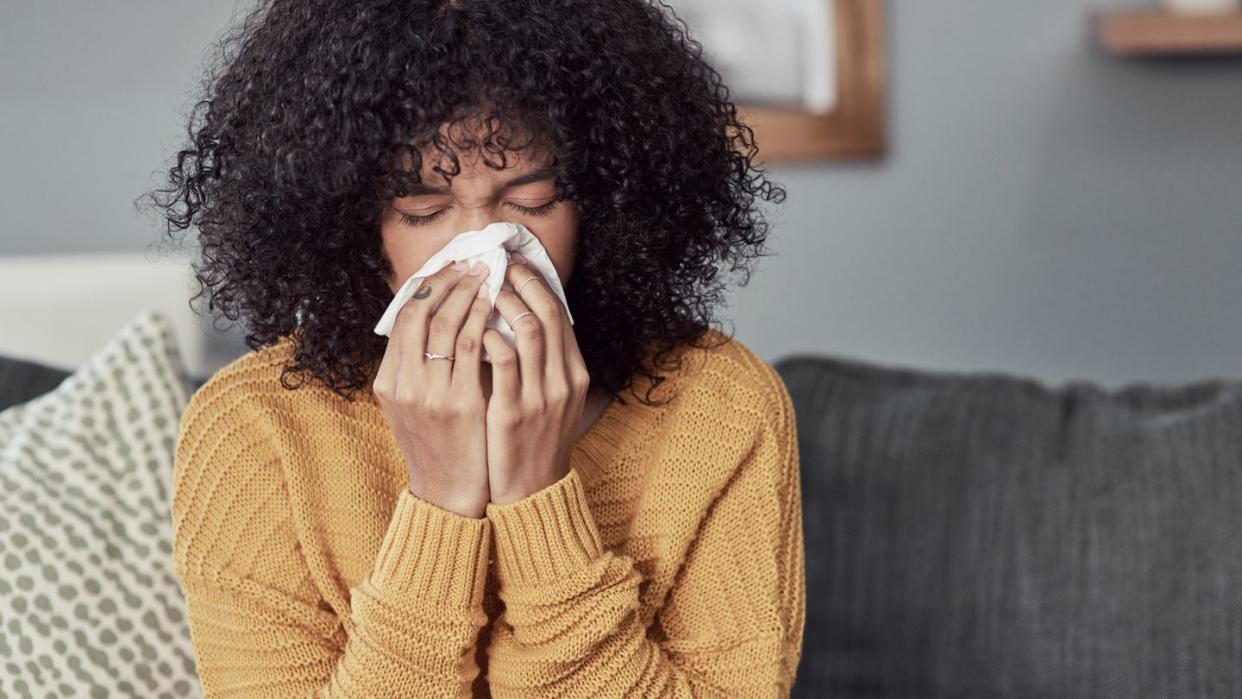Here’s How to Tell If You Have COVID, the Flu, or RSV

- Oops!Something went wrong.Please try again later.
Many respiratory viruses make the rounds in fall and winter, making this prime time to brush up on your knowledge of common illnesses. But if you or a family member suddenly gets sick, it can be tricky to know if you’re dealing with one of the big three respiratory viruses going around now—COVID-19, flu, and RSV.
So, what are the symptoms of COVID-19, flu, and RSV and, more importantly, how can you tell them apart? Infectious disease doctors say it can be tricky.
Meet the experts: Thomas Russo, M.D., is a professor and chief of infectious diseases at the University at Buffalo in New York; Amesh Adalja, M.D., is a senior scholar at the Johns Hopkins Center for Health Security
Here’s what you need to know.
What are the symptoms of COVID-19?
These are the main symptoms of COVID-19, according to the Centers for Disease Control and Prevention (CDC):
Fever or chills
Cough
Shortness of breath or difficulty breathing
Fatigue
Muscle or body aches
Headache
New loss of taste or smell
Sore throat
Congestion or runny nose
Nausea or vomiting
Diarrhea
Symptoms appear anywhere from two to 14 days after someone has been exposed, the CDC says.
What are the symptoms of the flu?
Flu symptoms tend to come on suddenly, according to the American Lung Association (ALA). They can include:
Sudden high fever
Headaches, muscle aches, and joint pain
Cough that’s usually dry
Sore throat
Nasal congestion and runny nose
Muscle body aches and chills
Fatigue
Nausea, vomiting, and diarrhea (this is more common in kids vs. adults)
What are the symptoms of RSV?
RSV symptoms usually show up between four and six days after someone has been infected, the CDC says. They can include:
Runny nose
Decrease in appetite
Coughing
Sneezing
Fever
Wheezing
How can you tell COVID, flu, and RSV apart?
This is tough. “All three of the viruses have overlapping or identical symptoms,” says Amesh Adalja, M.D., senior scholar at the Johns Hopkins Center for Health Security. “There is no reliable way to distinguish the viruses clinically.” Meaning, your doctor can’t look at you and tell right away if you have COVID-19, the flu, or RSV.
That said, there are some clues that you may be dealing with one virus over the other, says Thomas Russo, M.D., professor and chief of infectious diseases at the University at Buffalo in New York. A big one is knowing what you’ve been exposed to, he says.
“If you have a known exposure to someone and they have a diagnosis, like young children who were diagnosed with RSV, and you develop symptoms, it’s safe to assume that’s what you have,” Dr. Russo says. “It’s unusual to have two respiratory infections at the same time.”
The way the illness starts can also provide a clue, he says. Flu is known for coming on hard and fast, for example. If you suddenly develop symptoms and it feels like they came out of nowhere, Dr. Russo says it can be a “hint” that you may have the flu.
“At the end of the day, testing is key,” Dr. Russo says. While there is now only a home test for COVID-19, your doctor can give you a test to see if you have the flu or RSV, he points out.
How are treatments different for COVID, flu, and RSV?
When it comes to addressing symptoms, all three of these viruses have similar symptom-specific treatments, Dr. Russo says. That can include resting when you can, drinking plenty of fluids, and taking fever-reducing medications like acetaminophen or ibuprofen, he says.
But tackling the underlying illness is different. “COVID and flu have distinct antiviral treatments,” Dr. Adalja says. “It is necessary to first know what a patient has before you can prescribe the optimal antiviral.” For flu, people are usually prescribed antiviral medications like oseltamivir (Tamiflu) or balaxovir (Xofluza); For COVID-19, nirmatrelvir/ritonavir (Paxlovid) is usually used, he says.
Unfortunately, there’s no treatment right now for the average person who has RSV, Dr. Russo says.
If you develop symptoms like a cough, runny nose, or sore throat, Dr. Russo says it’s not a bad idea to test yourself for COVID at home first. If it’s negative, you can reach out to your doctor about getting tested for the flu and RSV.
How to protect yourself from COVID, flu, and RSV
Prevention for COVID-19, the flu, and RSV can be tricky when the viruses are swirling around. However, there are a few things you can do to lower your risk.
The first is getting up to date with your vaccines. That means getting your annual flu shot and the latest COVID-19 vaccine, Dr. Russo says. There’s also a vaccine for RSV for older adults and pregnant women, and antibody immunization for babies and toddlers, the CDC says.
Wearing a mask in crowded indoor spaces when cases of respiratory viruses are high will also help protect you, Dr. Russo says. Beyond that, washing your hands with soap and water for at least 20 seconds, avoiding touching your face with unwashed hands, avoiding close contact with others, and cleaning frequently-touched surfaces like doorknobs and your phone, can also help keep you healthy, the CDC says.
It’s possible to do everything right and still get sick, given how common these illnesses are. But, if you happen to develop cold-like symptoms, make sure you get tested—your doctor can help guide you on next steps from there.
You Might Also Like

